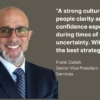
We’ve all seen bad behavior in the workplace. At times, we are even the ones at fault. Some studies indicate that 30-40% of a manager’s time is devoted to dealing with bad behaviors in the workplace! As we spend so much time on this problem, how prepared are we for appropriate responses to these behaviors? What is the danger of leaving them unresolved? Do we recognize what constitutes different kinds of bad behavior and understand the negative impact it can have on individuals, teams and organizations?
Bad behavior can exhibit itself in different ways – gossiping, negativity, apathy, constant complaining, and harassment in various forms. Many conflict resolution experts firmly believe that these bad behaviors are exhibited when natural psychological needs are not being met. While this does not excuse bad behavior, it is important for managers to understand their people and meet these innate psychological needs whenever possible. These needs, depending on the person and their personality, can include control, recognition, social interaction, stability, structure, process, independence, harmony, clarity, etc. While the goal is never to reward bad behavior, it is in the best interest of an organization to have individuals and teams to be in roles that are an appropriate fit for their natural drives and needs. It is also beneficial to both individuals and teams to have effective communication and bad behavior resolution.
Bad Behavior Response:
There are numerous ways to deal with bad behaviors but in my experience, I have found the S.B.I. Feedback Model to be highly effective and straightforward to use. The key with this is that you are dealing with observable behavior and not with perceived behaviors or attitudes. This model can even be practiced using positive situations!
- S – Situation
- Define the time and place that the situation happened in order to bring back the specific memory of when/where this bad behavior occurred. For example:
- “Yesterday in the meeting for the 2017 budget…”
- Define the time and place that the situation happened in order to bring back the specific memory of when/where this bad behavior occurred. For example:
- B – Behavior
- Define what you saw and/or heard that person do. It is VERY important that you are discussing behavior that was observed and NOT the perceived attitude or emotions behind the behavior. For example:
- “You yelled at your coworkers.” – RIGHT
- “You got really angry at your coworkers.” – WRONG
- This will keep the conversation from getting stalled on whether the individual was angry but instead focus on the behavior that was observed – the yelling.
- Define what you saw and/or heard that person do. It is VERY important that you are discussing behavior that was observed and NOT the perceived attitude or emotions behind the behavior. For example:
- I – Impact
- Explain then the impact of that behavior. How did that behavior impact you personally (what did you feel or think?) or the team as a whole?
There are many training videos and materials on this model that further explain how to use it and its benefits.
Behavioral Assessments:
There are also many tools to determine the behavioral needs of employees (including leadership) in the workplace. One that I recommend to clients for its simplicity and powerful results, and which is backed by science, research, and sophisticated data analytics, is The Predictive Index Behavioral Assessment. The Predictive Index behavioral assessment measures 4 core drives in people and their corresponding needs and behaviors. For example: A drive we all have is the drive to survive. This initiates the need to eat, which then initiates the behavior of going to a restaurant. Not satiating my need to eat will result in an upset stomach and headaches.
- Dominance – The need to influence or control people or situations
- Extraversion – The need for social interaction and relationship developing
- Patience – The need for stability and consistency
- Formality – The need for rules and structure
Low measures of these drives result in opposing needs. This assessment tool gives coaching and management material directly into the hands of managers and HR practitioners to assist in building cohesive and productive teams as well as providing self-coaching guides for assessment takers to become more self-aware.
Dealing with bad behavior? It’s part of life but how we handle it will make the difference in moving forward stronger and more self-aware. I leave with an analogous example: In 2011 the Red Sox historically destroyed one of the best leads in baseball by not addressing the terrible behaviors of some of their ‘star’ players. If they had dealt with bad behavior effectively they could have avoided attrition rates, poor performance, low morale and damage to their brand. So, don’t avoid the bad behaviors, instead address them head on, and build the strongest teams and relationships possible.
For more information on best practices for dealing with bad behavior or how to incorporate assessments please contact Joshua Combest at josh.combest@mcgpartners.com.
About the Author: Josh Combest, Senior Consultant
About MCG Partners
MCG Partners a woman-owned, Greater Boston-based consultancy specializing in executive coaching, leadership development, talent management, and organizational development solutions. We help businesses optimize success through the entire management life-cycle. MCG Partners is also a Predictive Index® (PI®) certified partner.
To learn more about MCG Partners’ services or The Predictive Index®, contact John Griffith at john.griffith@mcgpartners.com or visit mcgpartners.com.
[/fusion_text][/fusion_builder_column][/fusion_builder_row][/fusion_builder_container]








